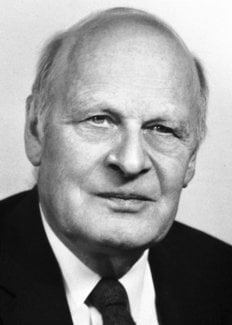Lars Onsager
Biographical

Lars Onsager was born in Oslo, Norway, November 27, 1903 to parents Erling Onsager, Barrister of the Supreme Court of Norway, and Ingrid, née Kirkeby. In 1933 he married Margarethe Arledter, daughter of a well-known pioneer in the art of paper making, in Cologne, Germany. They have sons Erling Frederick, Hans Tanberg, and Christian Carl, and a daughter Inger Marie, married to Kenneth Roy Oldham.
After three years with the experienced educators Inga and Anna Platou in Oslo, one year at a deteriorating private school in the country and a few months of his mother’s tutoring, he entered Frogner School as the family returned to Oslo. There he was soon invited to jump a grade, so that he was able to graduate in 1920.
Admitted to Norges tekniske høgskole in the fall of that year as a student of chemical engineering, he entered a stimulating environment; the department had attracted outstanding students over a period of years. Among the professors particularly O.E. Collenberg and J.P. Holtsmark encouraged his efforts in theory and helped him in the evaluation of background knowledge.
After graduation in 1925 he accompanied Holtsmark on a trip to Denmark and Germany, then proceeded to Zurich, where he remained for a couple of months with Debye and Hückel and returned the following spring, for a stay of nearly two years. There he organized his results in the theory of electrolytes for publication, broadened his knowledge of physics and became acquainted with a good many leading physicists.
In 1928 he went to Baltimore and served for the spring term as Associate in Chemistry at Johns Hopkins University. The appointment was not renewed; but C.A. Kraus at Brown University engaged him as an instructor, and he remained in that position for five years. During this time he gave lectures on statistical mechanics, published the reciprocal relations and made progress on a variety of problems. Some of the results were published at the time, one with the able assistance of R.M. Fuoss; others formed the basis for later publications. In 1933 he accepted a Sterling Fellowship at Yale University, where he remained to serve as Assistant Professor 1934-1940, Associate Professor 1940-1945 and JosiahWillard Gibbs Professor of Theoretical Chemistry 1945-1972. Incidentally, he obtained a Ph.D. degree in Chemistry from Yale in 1935; his dissertation consisted of the mathematical background for his interpretation of deviations from Ohm’s law in weak electrolytes.
Over the years, the subjects of his interest came to include colloids, dielectrics, order-disorder transitions, metals and superfluids, hydrodynamics and fractionation theory. In 1951-1952 he spent a year’s leave of absence as a Fulbright Scholar with David Schoenberg at the Mond Laboratory in Cambridge, England, a leading center for research in low temperature physics. In the Spring of 1961 he served as Visiting Professor of Physics at the University of California in San Diego. Of his sabbatical leave 1967-1968 he spent the first three months as Visiting Professor at Rockefeller University and the last three as Gauss Professor in Göttingen. In 1962, at the suggestion of Manfred Eigen, he joined Neuroscience Associates, a small interdisciplinary group organized by F.O. Schmitt in Cambridge, Massachusetts.
Lars Onsager holds honary degrees of Doctor of Science from Harvard University (1954), Rensselaer Polytechnic Institute (1962), Brown University (1962), Rheinisch-Westfahlische Technische Hochschule (1962), the University of Chicago (1968), Ohio State University (Cleveland, 1969), Cambridge University (1970) and Oxford University (1971), and Doctor technicae from Norges tekniske høgskole (1960).
In 1953 he received the Rumford Medal from the American Academy of Arts and Sciences, in 1958 The Lorentz Medal from The Royal Netherlands Academy of Sciences, in 1966 the Belfer Award in Science from Yeshiva University, in 1965 the Peter Debye Award in Physical Chemistry from the American Chemical Society, in 1962 the Lewis Medal from its California Section, the Kirkwood Medal from the New Haven Section and the Gibbs Medal from the Chicago Section, in 1964 the Richards Medal from the Northeastern Section.
In 1969 he received the National Science Medal, and he became an honorary member of The Bunsen Society for Physical Chemistry. During Spring 1970 he was Lorentz Professor in Leiden (The Netherlands).
Onsager is a Fellow of the American Physical Society and The New York Academy of Sciences, a member of The American Chemical Society, The Connecticut Academy of Arts and Sciences, The National Academy of Sciences, The American Academy of Arts and Sciences and The American Philosophical Society, a Foreign Member of the Norwegian Academy of Sciences, The Royal Norwegian Academy of Sciences, The Norwegian Academy of Technical Sciences, the Royal Swedish Academy of Sciences and The Royal Science Society in Uppsala, and an Honorary Member of The Norwegian Chemical Society.
This autobiography/biography was written at the time of the award and first published in the book series Les Prix Nobel. It was later edited and republished in Nobel Lectures. To cite this document, always state the source as shown above.
Lars Onsager died on October 5, 1976.
Nobel Prizes and laureates
Six prizes were awarded for achievements that have conferred the greatest benefit to humankind. The 12 laureates' work and discoveries range from proteins' structures and machine learning to fighting for a world free of nuclear weapons.
See them all presented here.
